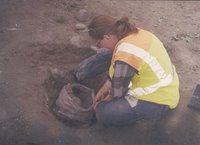Iron Age Holmsmalma

In 1999, my friend Jonas Wikborg directed the rescue excavation of an unexpectedly large and crowded urn cemetery at Holmsmalma and Gålby, Köping parish, Västmanland, Sweden. Jonas and his team dug 332 graves at the site, most dating from the centuries either side of year 1. Holmsmalma is a well-known name in Swedish archaeology thanks to work done there in the 60s and 70s by Henry Simonsson and Barbro & Stig Welinder, but they excavated a cemetery farther north along the ridge from Jonas's dig.
Jonas is always prompt with reports and in-depth papers, but his manuscripts on this dig have been languishing for years in various editorial offices. Now his studies of Holmsmalma, as well as papers about the site by Barbro Hårding and Thomas Eriksson, have finally appeared in a book from the Board of National Antiquities named Tidens resenärer, "Travellers in/of Time".
The Holmsmalma urn cemetery was a mix between western and eastern traditions. In the west around Gothenburg we get urn cemeteries with nice pottery and few superstructures. In the east around Stockholm we get really cool superstructures (such as those at Åby and Jordbro) but very little and rather ugly pottery. At Holmsmalma, there were urn burials with ugly pottery or bark boxes and little else. Hundreds of them.
But two of the graves were very nice. One was a weapon burial from the last century BC, about the time of Julius Caesar, with sword, scabbard, lance, shield and bear skin, all folded together and placed with the cremated bones in an oval resin-caulked bark box. The shield's handle is unique and suggests that local smiths cultivated designs of their own.
The other notable grave contained a truly weird object. This was another bark box burial, roughly contemporaneous with the weapon grave, with a few bronze and iron belt fittings. On top of them was a 26 cm long decorated sheet iron object looking like a miniature leg guard. It's unique, but shows enough similarities to a Danish wagon fitting that Jonas figures that's what it was. Sticking to its inside were two 1,8 cm disc-shaped tin wire ornaments that were too deteriorated to be saved.
So it appears that we're looking at a part of a cultic wagon along the lines of what Roman author Tacitus described in his book on Germania a century or two after the time of the Holmsmalma burials:
"There follow in order the Reudignians, and Aviones, and Angles, and Varinians, and Eudoses, and Suardones and Nuithones; all defended by rivers or forests. Nor in one of these nations does aught remarkable occur, only that they universally join in the worship of Herthum [Nerthus]; that is to say, the Mother Earth. Her they believe to interpose in the affairs of man, and to visit countries. In an island of the ocean [Tacitus believes that Scandinavia is a group of islands] stands the wood Castum [or an undefiled wood]: in it is a chariot dedicated to the Goddess, covered over with a curtain, and permitted to be touched by none but the Priest. Whenever the Goddess enters this her holy vehicle, he perceives her; and with profound veneration attends the motion of the chariot, which is always drawn by yoked cows.I wish I could dig a few graves like that. Without having to dig hundreds of boring ones as well.
Then it is that days of rejoicing always ensue, and in all places whatsoever which she descends to honour with a visit and her company, feasts and recreation abound. They go not to war; they touch no arms; fast laid up is every hostile weapon; peace and repose are then only known, then only beloved, till to the temple the same priest reconducts the Goddess when well tired with the conversation of mortal beings. Anon the chariot is washed and purified in a secret lake, as also the curtains; nay, the Deity herself too, if you choose to believe it. In this office it is slaves who minister, and they are forthwith doomed to be swallowed up in the same lake. Hence all men are possessed with mysterious terror; as well as with a holy ignorance what that must be, which none see but such as are immediately to perish." (Chapter 40)
Update. My friend Molle, lady fair and wise, asks me what superstructure means in this context. At a modern Christian cemetery, the grave superstructures are typically inscribed head stones. In the Viking Period, they were mounds or flat stone settings. In the last century BC, we find funny grave superstructures in parts of Sweden where geometric patterns have been "drawn" on the ground with lined-up pebbles. Here's an example from the celebrated Jordbro cemetery near Stockholm.
Leif Karlenby (ed.), Tidens resenärer. Arkeologiska händelser längs vägen mellan Köping och Kolsva. Stockholm: Board of National Antiquities 2005. 239 pp. ISBN 91-7209-403-6.
[More blog entries about Iron Age, burial, archaeology, Sweden; järnåldern, gravar, arkeologi, Köping, Västmanland.]



2 Comments:
Martin, I thought that I had taught you to be careful stating that a bearskin was present in a grave when there are finds of claws. Claws are powerful enough in themselves and bearskins are not necessary.
How many claws? I want that book for presentation. Can I get it?
Mattias A. Niord
It doesn't say how many phalanges there were in this particular grave. But there were more than one, and twenty was the largest number found in any of the graves. That means, no evidence of more than one skin in any grave.
Post a Comment
<< Home